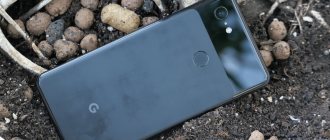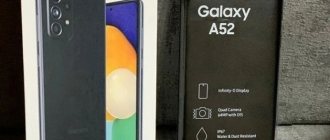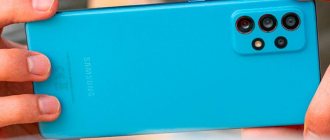There are at least six smartphones in Vivo's X60 lineup, and one of the most interesting is the Vivo X60 Pro. It is powered by the powerful Snapdragon 870 processor and has a 6.56-inch 120Hz AMOLED display.
The new X60 Pro is in many ways similar to the regular X60, there is also a version of the X60t with the Dimensity chipset instead of Snapdragon, however, in all other respects these models are very similar.
Specifications Vivo X60 Pro
| Screen | 6.56 inches AMOLED, resolution 2376×1080 pixels, 120 Hz, HDR10+, aspect ratio 19.8:9, 398 ppi |
| CPU | Qualcomm SM8250-AC Snapdragon 870 5G (7 nm): Octa-core (1x3.2 GHz Kryo 585 and 3x2.42 GHz Kryo 585 and 4x1.80 GHz Kryo 585) |
| Graphic arts | Adreno 650 |
| RAM | 12 GB |
| Inner memory | 256 GB UFS 3.1 |
| System and software | Android 11, Funtouch 11.1 |
| Main cameras | 48 MP, f/1.5, 26 mm, 1/2.0 inch, 0.8 µm, PDAF, stabilization + 13 MP telephoto, f/2.5, 50 mm, 1/2.8 inch , 0.8 µm, PDAF, 2x optical zoom + 13 MP, ultra-wide, f/2.2, 120˚, 16 mm |
| Front camera | 32 MP, wide, f/2.5, 26 mm, 1/2.8″, 0.8 µm |
| Communications and connections | 5G, Dual 4G VoLTE, Wi-Fi 6, Bluetooth 5.1, NFC, GPS (L1 + L5 Dual Band), USB Type-C |
| Safety | Fingerprint scanner (under-display, optical) |
| Battery | 4200 mAh; Fast charging 33W |
| Materials | Gorilla Glass 6 front and back, aluminum frame |
| Dimensions and weight | 158.6×73.2×7.6 mm, 179 grams |
| Price | 53,000 rub. |
Zoom, wide, front camera
The wide angle is at the mercy of a 13 MP matrix with a 16 mm or 120˚ lens. The matrix takes good pictures with minor distortions in the corners - at the level of more expensive and advanced competitors. The module also boasts autofocus - a rarity for such cameras.
Shirik Auto
2x
Shirik Main camera 2x
Wider, by the way, is not available when recording 4K and 1080p video, but only at 60 fps. At 30 FPS everything works.
The telephoto is also 13 megapixels, and the focal length of 50 mm provides only 2x optical zoom. The rest is left to the digital, which greatly spoils the picture.
Shirik
Auto 2x
And by the way, for some reason the optical zoom does not work during 4K video recording - only digital zoom with corresponding losses in quality. When shooting 1080p, everything is available.
At the front there is a 32-megapixel front camera with f/2.45 aperture. There is nothing outstanding, however, nor anything disastrous about it. Just a good sensor.
Selfie
Packing and unpacking
The Vivo X60 Pro comes in a more attractive box than most other smartphones, which fits well with a premium device. It is a flat square, painted dark blue, with the model name in large letters, an image of the camera lens and the Zeiss brand.
In the box we also get:
- Plastic case
- Charger
- 3.5mm to USB-C adapter
- Headset with 3.5 mm plug
- USB-A-to-C combo cable.
Summing up
Vivo X60 Pro turned out to be a worthy successor to last year's X50 Pro. Despite the lack of water protection, wireless charging and stereo, it confidently holds its own.
It has one of the best cameras on the market, equipped with a rare stabilizer, fast Zeiss optics and incredibly powerful algorithms. If you love photography and cannot live without beautiful pictures, then you should definitely take a closer look at the vivo X60 Pro. Here he will undoubtedly delight.
pros
- Autonomy
- One of the best cameras
- Very fast charging
- Keeps a stable connection
- Design and slim body
- Large performance margin
Design and appearance
Vivo X60 Pro looks like a real flagship. The body is made of glass and aluminum with all sides rounded. There are almost no fingerprints on the back cover, but the panel itself is very slippery, as it is covered with Gorilla Glass 6.
There are two body colors, one is called “Midnight Black”, the second, brighter, “Shimmer Blue”. It is difficult to describe the latter with one color; the shades shimmer depending on the angle of inclination and can vary from purple to copper.
All three main cameras are located in a single module under glass. The main one is located at the top, and below it are the ultra-wide-angle and telephoto lenses. In the upper right corner you can see a tiny logo of Zeiss, which is an optics manufacturer. The whole set sticks out quite a lot, but inside there is a stabilizer for the main sensor. The characteristics of the lenses are described below, and the flash is located to the left of them.
Due to the rounded edges of the display and the back cover, the side frames are very thin. On the right are the power and volume keys; the buttons themselves are metal and press with a pleasant response. At the bottom you can find a USB-C connector, the main speaker and microphone, next to it is a slot for two nano-SIM cards. There is no microSD support, as well as a 3.5 mm headphone jack. At least the kit includes an adapter.
The bezels around the display are minimal, with a fairly large hole for the front camera located in the middle. Many people may not like the rounded screen, but you won’t have any accidental clicks. Thanks to the AMOLED panel, the X60 Pro's fingerprint scanner is located under the display; it is optical, works reliably and quickly. However, the scanner is installed quite low.
The dimensions of the X60 Pro are 158.6 x 73.2 x 7.6 mm and the weight is 179 grams. The case doesn't feel overly large or heavy and is smaller than the OnePlus 9, Mi 11 and many other competitors.
Contents of delivery
The packaging design, with its iridescent shine, resembles the starry sky, and the flat shape of the box emphasizes that the thickness of the phone is a record 5G 7.3 mm.
Inside there is a standard set of cable, adapter, wired headphones, bumper and key. The instructions begin with text in Russian, which is especially convenient for the Russian user.
Headphones and cable are packaged in laminated cardboard, instructions are supplied without a plastic bag. This correlates with the popular concept of zero waste and will please those who are partial to the topic of ecology.
Each component is pleasant to look at and hold in your hands. And after unpacking, you don’t have to throw away a mountain of film, plastic and unnecessary wrapping.
Display 120 Hz
The Vivo X60 Pro smartphone boasts an excellent 6.56-inch AMOLED display, Full HD resolution with a refresh rate of 120 Hz, and a touch layer polling rate of 240 Hz.
Brightness reaches 818 nits in adaptive mode, although manually it can be raised to 472 nits, which is also good. It is also important that the shades are quite accurate. The “professional” color profile corresponds to the sRGB space, so the colors will only slightly blend towards warmer ones. The default "Standard" profile appears bluer, although the color temperature is easy to adjust using the slider.
Another nice bonus is HDR10+ support, you can watch HDR content on YouTube and Netflix. The refresh rate in this case can be 60 Hz or 120 Hz. There is also a Smart Switch mode, in which 120 Hz is activated only when you press the screen.
Games
The device supports an “esports mode” that blocks notifications and makes maximum use of hardware resources. You can select ultra settings in most popular shooters and adventure games. PUBG, Call of Duty, LifeAfter run on vivo without delays and with an excellent picture.
The only surprise for players may be the location of the phone's front camera. During the game, the image completely occupies the display, so the lens is located directly on the screen in the form of a strange black dot.
X60 Pro Cameras
On the back of the Vivo X60 Pro there is a set of three cameras. It is curious that the main one is installed on a movable platform (gimbal), which provides better stabilization.
The sensor itself is a Sony IMX598 with a resolution of 48 MP. The ultra-wide-angle camera shoots in 13-megapixel resolution. More importantly, there is phase detection autofocus, which allows you to focus on both distant and close objects. The whole set is complemented by a 13-megapixel telephoto lens with 2x zoom.
The shooting application here is standard from Vivo. It is worth noting the Pro mode, which works with all three cameras. You can adjust ISO (50–3200), shutter speed, white balance, focal length and exposure compensation.
Photos taken from the main sensor look very rich – this can be seen even in the preview. Calmer shades would have looked nicer, but Vivo probably tried to follow modern trends. Contrast is very high and dynamic range is fine. The final photo resolution is 12 MP. Detail is good, but blur is visible in some places, although there is almost no noise. The 48-megapixel mode should not be turned on - the detail is not much higher, but there will be much more noise.
The ultra-wide-angle camera on the X60 Pro is one of the best in the segment. Photos have incredible clarity when the dynamic range is very wide. Autofocus allows you to take great close-up photos, replacing a separate macro camera.
The Vivo X60 Pro cameras also cope well with low lighting. The shades seem too saturated, although in the evening this can even be an advantage. However, the detail is almost as high as during the day.
The X60 Pro's front camera is 32MP, which is quite high for close-up facial shots. Portrait photos look nice, although their colors are not as saturated. But determining the boundaries of an object in Portrait mode could be implemented better.
You will also have access to video recording in 4K/60 fps from the main camera and 1080p/30 fps from the ultra-wide-angle camera. At the same time, there are two types of stabilization: normal for all sensors and “Super-stable” mode for the main camera at 1080p/60 fps.
⇡#Camera
So, we finally got to the key point of the program - the camera, around which, in fact, the entire vivo X60 Pro is built. It is curious that with maximum emphasis on this area, “only” a triple module is used here, while most modern smartphones, including much more budget ones, have blocks of four cameras. The fact is that vivo is simply not trying to show off - there is no depth sensor or specialized macro camera here. Only three cameras, corresponding, in fact, to three focal lengths - 16 mm, 26 mm and 50 mm in 35 mm equivalent.
The key camera here, as usual, received a lens with a focal length of 26 mm. The sensor is the same as in the X50 Pro - the same super-popular Sony IMX598, made according to the Quad Bayer scheme, with a resolution of 48 megapixels (the size of an individual pixel is 0.8 microns). But the optics have been updated. There is also an improved stabilization gimbal, which provides correction of movements along five axes when shooting both photos and videos, and a faster lens itself - f/1.48.
| On the left are pictures in the default format, on the right are with night mode activated | ||
Therefore, as in the case of the X50 Pro, let’s immediately move on to night photography, which has again become the main feature of the smartphone. Above you can see examples of night photography in the forest using the main camera. The light level can be seen in the left pictures. On the right is what the vivo X60 Pro is capable of in night mode with multi-frame stitching. It’s probably not worth saying that we are dealing with a perfect tool for shooting in pitch darkness - the detailing is far from ideal. But the fact that a smartphone in this mode “sees” more than the human eye and is capable of producing a completely acceptable, noise-free and relatively sharp picture is impressive. The problem of blur when shooting with the main camera is practically absent even when shooting at long (up to a second) shutter speeds, not to mention multi-frame compositions typical for night mode.
Separately, which is available both when installing the smartphone on a tripod or some stable surface (then the smartphone itself determines the shutter speed, which can reach a couple of minutes), and when shooting handheld. Examples of photos in this mode are above. You can pay attention to the characteristic cold toning, which is suitable for shooting stars - and, unfortunately, to noticeable artifacts at the “junctions” of objects and the sky. The smartphone is definitely trying to “find out” the picture using artificial intelligence - and making mistakes. However, don’t be too critical - the result is still very impressive. There is also a “Supermoon” mode, which allows you to photograph the Moon relatively clearly with software zoom, but it was not possible to test it - the Earth’s natural satellite was simply not visible during the week of testing the X60 Pro.
| From left to right: shooting at wide angle, standard focal length and 2x zoom | ||||
In addition to the main module, vivo X60 Pro has two more installed. Firstly, it is a wide-angle module with dimensions of 1/4.0 inches and a resolution of 13 megapixels with an f/2.2 lens - alas, now without autofocus. Secondly, this is a camera responsible for a 2x optical zoom, with a 13-megapixel sensor and an f/2.5 lens - and already with phase detection autofocus. Unfortunately, in the additional cameras there is some regression compared to what we saw in the X50 Pro, where the wide-angle module (of lower resolution, however, there was an 8-megapixel one) used autofocus, and there was also a periscope module with optical stabilization, which added an option five times zoom. Here such zoom is available only in software.
In terms of the overall quality of shooting in normal lighting, it’s hard to find fault with the vivo X60 Pro - with natural light and relatively bright artificial light, all three modules cope perfectly, producing very clear, albeit not always uniform in white balance (depending on the focal length used, it can “dance” a little) a picture with good color rendition. In the dark, of course, only the main module works to its full potential - a wide-angle camera in very low light is not applicable at all, a zoom module with night mode turned on may well produce a photograph with discernible details, but blur is also possible - an optical stabilizer for this camera, let me remind you , not provided.
| On the left are pictures in 12 megapixel resolution, on the right - in 48 megapixel resolution | ||
The main camera can shoot both in the default “compressed” resolution of 12 megapixels, and using all subpixels, that is, 48 megapixels. You won't see a real fourfold improvement in detail, but clarity does increase.
| On the left is an example of shooting without the participation of “artificial intelligence”, on the right - with “artificial intelligence” | ||
As in vivo X50 Pro, the neural network assistant, which detects scenes and adjusts the result at its discretion, is very active - it strongly, although selectively, raises saturation and further tightens contour sharpness. But, unlike its predecessor, in the X60 Pro you can control this intelligent assistant directly from the main shooting screen; you don’t need to go into deep settings for this.
A little more “artificial intelligence” can be found in specialized night filters that give the picture an unusual character: from emphasizing cinematic yellow-blue tones to a cyberpunk pink-green palette. We saw these spectacular filters already on the vivo Y31, but here, in a smartphone ideal for night photography, they seem even more appropriate.
For macro photography, oddly enough, it is not the wide-angle module that is used, but the main one, which has a short minimum focusing distance. Thanks to this, the close-ups of the X60 Pro are especially impressive - the large size of the sensor and the stabilizer allow you to rely on it even in low light, the blur zone looks great, and there is no damage to image quality due to insufficient sensor resolution, as on smartphones with specialized macro cameras. In addition, there is full autofocus.
Portrait mode is the second area, along with night photography, on which special emphasis is placed. Despite the absence of a special depth sensor, the artificial bokeh mode is in place, moreover, supported by a scattering of filters, including those associated with Zeiss - it’s not for nothing that the company’s name is written on the camera block. There is, for example, a Zeiss Biotar filter that simulates the blur that is obtained using Zeiss portrait optics. But there is also a set of simpler filters that turn the lights in the background into flowers and stars - a little clumsy, but why not.
It is very important that for portrait photography you can use both the main module with an EGF of 26 m and a zoom module with an EGF of 50 mm, which in theory should greatly expand the photographer’s capabilities. But the quality of portrait photography with these two modules, unfortunately, differs significantly - while with the main module we can get a sharp picture with a perfectly defined artificial defocus zone, the zoom module suffers from errors in rendering bokeh and suffers from a lack of sharpness on the model’s face. These are probably software problems with the pre-production model, and they will disappear over time, but for now only the main module, which allows you to make full-length and half-length portraits, seems truly applicable in this format.
| vivo camera app interface | ||||||
The camera app in vivo X60 Pro has finally changed towards a more standard one. There is no more confusing navigation with the separation of supposedly homogeneous modes into different submenus, access to the “intelligent assistant” is also direct, navigation in general is very clear. Just a couple of questions - why in the main carousel the photo mode is called “Take a picture” and why it and the video mode are highlighted in capital letters against the background of the standard portrait and night shooting modes. It’s also worth saying that by default a watermark is placed on the photo with the name of the smartphone and the time it was taken - the first thing you need to do is find this creepy function in the settings and disable it. By the way, in the proprietary gallery there is no way to clear a photo of watermarks with one button, like Xiaomi - if you missed this point, you will either have to live with the inscriptions on the pictures, or use subtle tools in Photoshop.
vivo X60 Pro
View all images (27)The smartphone can record 4K video at up to 60 frames per second without stabilization. Electronic stabilization is only available at 30fps at maximum resolution and at 60fps at resolutions up to Full HD. There is also a super stabilization mode (available in a maximum of Full HD 30p), in which it is almost impossible to make the image shake (if you do not jump or run headlong), the picture is very smooth. The rolling shutter effect is weakly expressed. When shooting in any resolution (but not in super stabilization mode), you can switch between two focal lengths - standard and 2x zoom. Shooting with a wide-angle camera is available in a maximum of Full HD resolution - and without the ability to switch to other focal lengths. Also about the 2.35:1 shooting mode, in which the smartphone selects the central subject and keeps it in focus. By the way, constant focusing is also available when taking photos in sports mode.
The front camera in vivo X60 Pro moved from vivo X50 Pro unchanged: 32 megapixels, wide-angle lens (26 mm) f/2.5 aperture. There is no autofocus or flash, but the camera shoots quite well in low light. There is a powerful beautifier and a software background blur system. There is also a scattering of branded filters available.
Software
Vivo X60 Pro runs on the Android 11 operating system with Funtouch 11 shell. The interface is quite different from pure Android, although the main elements are easily recognizable.
The application drawer and task manager look standard, as do the round icons in the notification panel. Conveniently, turning on the automatic brightness mode is located right next to the brightness adjustment slider.
Since Funtouch 11 is based on Android 11, there are all the new features of this OS version. For example, notifications are grouped into categories. If you accidentally swipe one of them, you can view the history. Other important features include Messenger Bubbles, easier permission management, and built-in screen recording.
In the X60 Pro, Vivo left its applications for calls and messages. iManager, a program for clearing caches, scanning for viruses and many other tasks, has not gone away either. There is a convenient Ambient light function, illumination along the edges of the display, which turns on when receiving notifications or calls. You can choose which applications the option will work in. Moreover, there is a setting for the style of its illumination and even duration. This is an excellent replacement for an LED indicator.
Ultra Game Mode is also available. In addition to the usual functions, such as turning off notifications, one interesting feature has been added here. You can turn off the screen while the game is running. This will save a lot of energy in certain types of turn-based strategy and online games.
Incredibly beautiful
At a time when many manufacturers are abandoning glass and gradients in favor of monotonous plastic, Vivo releases a device with beautiful frosted glass. In other words, Vivo X60 Pro is perceived as a breath of fresh air against the background of the existing monotony. The back cover combines a whole palette of neon shades: blue, turquoise, purple and pinkish-orange. Each of them shimmers beautifully and plays with the lighting.
Thanks to the frosted glass, the gradient does not seem pretentious, despite the bright colors. The second advantage is practicality, Vivo X60 Pro does not slip out of your hands and is not covered in fingerprints. Small scratches are also completely invisible. The width of 73.24 millimeters is optimal for using a smartphone with one hand.
Another cool detail is the flat top and bottom ends, as well as the highly curved display. The smartphone looks and feels very expensive, you want to twirl it in your hands and look at it. The assembly is monolithic, the materials have confirmed their wear resistance after two weeks of careless use. To complete the picture, there is not enough protection at least from splashes.
For those who want to keep the case in its original form and protect the protruding camera, there is an equally remarkable case. Firstly, it is plastic, not silicone. That is, it is lighter and more compact, and over time it will not lose its shape or turn yellow.
Secondly, the overlay does not extend onto the side edges for better interaction with the screen.
Component Performance
Vivo X60 Pro uses Snapdragon 870 as a processor. This is the second most powerful chipset from Qualcomm after SD888. There are eight cores here in a 1+3+4 configuration, and the main clock frequency reaches 3.2 GHz.
Vivo is widely touting its Virtual RAM technology, which is supposed to increase the performance of the smartphone. The bottom line is that 3 GB of internal UFS 3.1 storage is allocated for non-critical processes in the background. In theory, this way the device can support many applications. However, there is already 12 GB of RAM, which should be enough for a huge number of tasks.
In performance tests, the X60 Pro shows excellent results. In Geekbench 5 multi-core mode, the smartphone scores 3490 points and is second only to OnePlus 9 with Snapdragon 888. In AnTuTu 8, the situation is similar - the gadget shows a result of 640 thousand points, only OnePlus 9 is better than it.
The GFXBench graphics test showed that the Vivo device is inferior to the OnePlus 9 by about 20%. The Galaxy S21+ also has better results, but that's understandable. Among the smartphones that do not use SD888, the X60 Pro is the most powerful. Therefore, the combination of Snapdragon 870, fast UFS 3.1 storage and 12 GB of RAM with 3 GB of “virtual” memory gives good results.
If you want maximum performance, you should choose a smartphone with a Snapdragon 888 processor.
What is 5-axis professional stabilization?
Last year's Vivo X50 Pro's camera was surprising on two fronts. In the new product, the design has not fundamentally changed, so everything said below is also relevant for the X60 Pro.
The first feature is the stabilization work due to the movements of the matrix itself, and not the lens, as is implemented in 99% of smartphones. In Vivo flagships, hand movements and shaking are compensated by a solid sandwich of matrix and lens. The structure is mounted on special hinges that move back and forth under the influence of two magnets, in conjunction with the accelerometer and gyroscope of the device.
Following Vivo, Apple decided to move the matrix itself. The main sensor of the iPhone 12 Pro Max can move along 2 axes. And unlike the iPhone, the new product from Vivo can move the module in as many as 5 directions. And this is the second revolutionary feature.
5-axis stabilization
Often in smartphones, optical stabilization works by moving the lens up and down and left and right, that is, 2-axis stabilization is used. More advanced devices already use 3-axis stabilization - the lens also moves diagonally. It is rare to find a 4-axis stub, which also implies the movement of the lenses back and forth. However, our hero went even further.
The 48 MP Sony IMX589 matrix can tilt within 3 degrees forward and backward, as if nodding and deviating from the main plane of the smartphone. This is the same 5th axis of stabilization or the principle of Gymbal 2.0 according to Vivo.
The operation of the suspension is noticeable even to the naked eye.
Sound quality
Like most mid-range Vivo models, the X60 Pro only has a single speaker. In this price segment, most already have stereo, so here the smartphone is a bit disappointing.
At least the volume is not bad, although the sound quality is not good enough. Mid frequencies don't sound very pleasant when there are almost no lower frequencies.
ZEISS optics
Firstly, the X60 Pro glass was lent by not the last company in the world that produces high-quality and iconic lenses for photo and video cameras.
Secondly, the smartphone has acquired a ZEISS Biotar software filter, which simulates swirling bokeh in portrait mode. It actually looks more luminous.
Regular portrait ZEISS Biotar filter Motion shot
You can also shoot portraits with two cameras: the main one with a focal length of 25 mm and a telephoto lens at 50 mm - according to the classics.
Battery autonomy
Inside the Vivo X60 Pro there is a 4200 mAh battery. By today's standards, this is not much - most competitors have at least 4500 mAh. Naturally, the battery life here is not the most impressive. One charge of the smartphone is enough for 10 hours of web surfing or 20 hours of watching videos.
The X60 Pro comes with a 33 W charger, which will restore about 70% of the energy in half an hour, and 100% in 55 minutes. The speed is not bad, however, not the highest in this segment. For example, OnePlus 9 charges from zero to 100% in just 30 minutes.
Review after two weeks of use
The primary purpose of the Vivo X60 Pro is taking photos and videos. For this, there is everything you need: three modules with different focal lengths, advanced optical stabilization and bright Zeiss optics. The only thing that confuses me is the 2x optical zoom, but that's a matter of personal preference. There are also problems with night photography, although this is part of positioning. The design and performance are up to par, but there are a few options missing to complete the picture. Namely: good sound from the speaker and moisture protection, because we have a device for 65 thousand rubles.
Pros:
- chic appearance with frosted rear glass;
- bright rounded screen;
- good ergonomics;
- good plastic case included;
- powerful Snapdragon 870 chip with large memory capacity;
- quality cameras.
Minuses:
- flat sound from a single speaker;
- lack of any moisture protection;
- noisy night photos.
May not like:
- just 2x optical zoom;
- incompatibility of fast charging with Qualcomm QuickCharge and Power Delivery.
Vivo X60 Pro cost and alternatives
The main competitor, the OnePlus 9, will cost you about the same as the X60 Pro, although it is superior in some aspects. For example, OnePlus 9 runs on the Snapdragon 888 processor, the most powerful from Qualcomm at the moment. It also has stereo speakers and has better battery life. However, the X60 Pro has the advantage of a telephoto lens with 2x zoom.
Another good option is the Samsung Galaxy S20 Plus, which has a better screen, stereo speakers and IP68 water protection. But not everyone likes Samsung smartphones, and the autofocus of Vivo's ultra-wide-angle camera is an advantage when shooting.
X60 Pro from Vivo is a great smartphone that does not disappoint in any way, although it costs from 53 thousand rubles.
Vivo X60 Pro on AliExpress
Bright and subtle
Flagship smartphones always turn out beautiful, and the vivo X60 Pro was no exception. Here we have a nice matte body with a beautiful gradient pattern that does not leave fingerprints. There is Gorilla Glass 6 on the front and back, and an aluminum frame on the sides. The smartphone turned out to be thin and light enough for a device with a large screen and an advanced camera system.
In terms of ergonomics, almost everything is excellent: a couple of convenient buttons on the right side, a fingerprint scanner is built into the screen, it works instantly and without failures. The Vivo X60 Pro turned out to be moderately wide and grippy - it is not slippery, it fits well in the hand for a large smartphone, and the only thing I can complain about is the screen with sloping edges. You need to adapt to the fact that part of the interface, the same keyboard buttons, is used on them. But I can’t complain about false positives either; I didn’t have any accidental touches.
In the kit we get a case to protect the phone, and this is not a silicone case, but a more pleasant and durable plastic cover. Unfortunately, the phone does not have water protection, so be careful when shooting near bodies of water.
Ergonomics
The device is a direct continuation of the Vivo X50 Pro and is practically no different from it in appearance: the same size, the construction of elements on the lower and right ends, a glass plate on the top with the inscription “Professional Photography” - it is made in the style of the Nokia Lumia 920, which is an obvious reference on the target orientation of the smartphone – photographs. In addition, a noise reduction microphone is installed at the same end.
The display has an under-screen ultrasonic fingerprint scanner, similar to the rear camera unit, which, however, does not have a periscope module that allows you to zoom the image up to 50x. The company felt that eliminating this sensor was appropriate due to lack of user interest and allowed for the installation of other components.
The bottom end is made of solid aluminum. It contains a tray for two SIM cards, a voice microphone, a USB Type-C port and a multimedia speaker. As in the previous device, there is a plastic cutout for the antenna, but it has become less noticeable.
The physical control buttons for the smartphone are on the right side. “Volume” in the form of a monolithic paired key.
The back of the device is made of matte tempered glass of increased strength - breaking or scratching it will be problematic - which means you can carry the smartphone without a bumper. In reality, I happened to drop the device on the asphalt without a cover, but only the lower end, made of aluminum, was damaged, and the back cover remained intact. The three-section flash has become two-section and, as we wrote, there is a 50x periscope module – a privilege of last year’s smartphone.
The front side is entirely occupied by a rounded display. At the very top there is an almost invisible front camera and even more invisible - a voice speaker.
It feels like the smartphone has become thinner and lighter. However, the battery size remains the same. Whether the company did the right thing by deciding not to increase its capacity will become clear at the end of the review.











